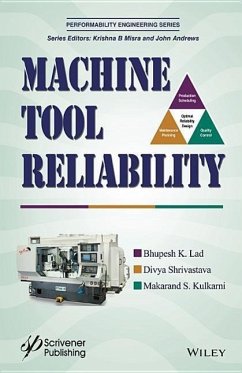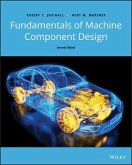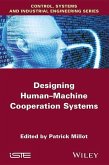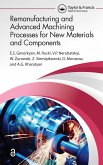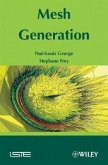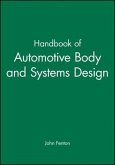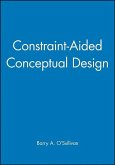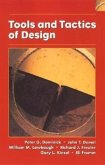- Gebundenes Buch
- Merkliste
- Auf die Merkliste
- Bewerten Bewerten
- Teilen
- Produkt teilen
- Produkterinnerung
- Produkterinnerung
This book explores the domain of reliability engineering in the context of machine tools. Failures of machine tools not only jeopardize users' ability to meet their due date commitments but also lead to poor quality of products, slower production, down time losses etc. Poor reliability and improper maintenance of a machine tool greatly increases the life cycle cost to the user. Thus, the application area of the present book, i.e. machine tools, will be equally appealing to machine tool designers, production engineers and maintenance managers. The book will serve as a consolidated volume on…mehr
Andere Kunden interessierten sich auch für
![Fundamentals of Machine Component Design Fundamentals of Machine Component Design]() Robert C JuvinallFundamentals of Machine Component Design214,99 €
Robert C JuvinallFundamentals of Machine Component Design214,99 €![Designing Human-Machine Cooperation Systems Designing Human-Machine Cooperation Systems]() Designing Human-Machine Cooperation Systems226,99 €
Designing Human-Machine Cooperation Systems226,99 €![Remanufacturing and Advanced Machining Processes for New Materials and Components Remanufacturing and Advanced Machining Processes for New Materials and Components]() Gevorkyan & .Remanufacturing and Advanced Machining Processes for New Materials and Components154,99 €
Gevorkyan & .Remanufacturing and Advanced Machining Processes for New Materials and Components154,99 €![Mesh Generation Mesh Generation]() Pascal FreyMesh Generation307,99 €
Pascal FreyMesh Generation307,99 €![Handbook of Automotive Body and Systems Design Handbook of Automotive Body and Systems Design]() John FentonHandbook of Automotive Body and Systems Design340,99 €
John FentonHandbook of Automotive Body and Systems Design340,99 €![Constraint-Aided Conceptual Design Constraint-Aided Conceptual Design]() Barry A O'SullivanConstraint-Aided Conceptual Design272,99 €
Barry A O'SullivanConstraint-Aided Conceptual Design272,99 €![Tools and Tactics of Design Tools and Tactics of Design]() Peter G DominickTools and Tactics of Design105,99 €
Peter G DominickTools and Tactics of Design105,99 €-
-
-
This book explores the domain of reliability engineering in the context of machine tools. Failures of machine tools not only jeopardize users' ability to meet their due date commitments but also lead to poor quality of products, slower production, down time losses etc. Poor reliability and improper maintenance of a machine tool greatly increases the life cycle cost to the user. Thus, the application area of the present book, i.e. machine tools, will be equally appealing to machine tool designers, production engineers and maintenance managers. The book will serve as a consolidated volume on various dimensions of machine tool reliability and its implications from manufacturers and users point of view. From the manufacturers' point of view, it discusses various approaches for reliability and maintenance based design of machine tools. In specific, it discusses simultaneous selection of optimal reliability configuration and maintenance schedules, maintenance optimization under various maintenance scenarios and cost based FMEA. From the users' point of view, it explores the role of machine tool reliability in shop floor level decision- making. In specific, it shows how to model the interactions of machine tool reliability with production scheduling, maintenance scheduling and process quality control.
Hinweis: Dieser Artikel kann nur an eine deutsche Lieferadresse ausgeliefert werden.
Hinweis: Dieser Artikel kann nur an eine deutsche Lieferadresse ausgeliefert werden.
Produktdetails
- Produktdetails
- Verlag: Wiley
- Seitenzahl: 336
- Erscheinungstermin: 4. April 2016
- Englisch
- Abmessung: 231mm x 155mm x 25mm
- Gewicht: 640g
- ISBN-13: 9781119038603
- ISBN-10: 111903860X
- Artikelnr.: 41753228
- Herstellerkennzeichnung
- Libri GmbH
- Europaallee 1
- 36244 Bad Hersfeld
- gpsr@libri.de
- Verlag: Wiley
- Seitenzahl: 336
- Erscheinungstermin: 4. April 2016
- Englisch
- Abmessung: 231mm x 155mm x 25mm
- Gewicht: 640g
- ISBN-13: 9781119038603
- ISBN-10: 111903860X
- Artikelnr.: 41753228
- Herstellerkennzeichnung
- Libri GmbH
- Europaallee 1
- 36244 Bad Hersfeld
- gpsr@libri.de
Bhupesh Kumar Lad is an Assistant Professor in Mechanical Engineering at the Indian Institute of Technology Indore. He is associated with Industrial Engineering Research Group at IIT Indore. He gained his PhD in Reliability Engineering from the Department of Mechanical Engineering at the Indian Institute of Technology Delhi (IITD). Before joining IIT Indore he was working with GE global research center, Bangalore as a research engineer. Divya Shrivastava is an Assistant Professor with in Mechanical Engineering at the Shiv Nadar University, India. She gained her PhD in Industrial Engineering from the Department of Mechanical Engineering at the Indian Institute of Technology Delhi (IITD). Before joining Shiv Nadar University she was working with NIT Hamirpur (H.P). Her area of research includes: Operations Management, Quality Control and Maintenance Management. M. S. Kulkarni is an Associate Professor in the Department of Mechanical Engineering at the Indian Institute of Technology Delhi. He is associated with the Industrial Engineering group of the Department. He gained his PhD in Manufacturing Engineering from the Department of Mechanical Engineering at the Indian Institute of Technology Bombay. His post PhD industry experience includes application of quality and reliability engineering techniques in manufacturing and service industry.
Preface xi
1 Introduction 1
1.1 Basic Reliability Terms and Concepts 2
1.2 Machine Tool Failure 6
1.3 Machine Tool Reliability: Manufacturers' View Point 7
1.4 Machine Tool Reliability: Users' View Point 11
1.5 Organization of the Book 12
2 Basic Reliability Mathematics 17
2.1 Functions Describing Lifetime as a Random Variable 17
2.2 Probability Distributions Used in Reliability Engineering 21
2.2.1 Exponential Distribution 21
2.2.2 Weibull Distribution 22
2.2.3 Normal Distribution 23
2.2.4 The Lognormal Distribution 23
2.3 Life Data Analysis 24
2.3.1 Empirical Methods 27
2.3.2 Unbiased Estimation of Parameters 28
2.4 Stochastic Models for Repairable Systems 28
2.5 Simulation Approach for Reliability Engineering 31
2.6 Use of Bayesian Methods in Reliability Engineering 32
2.7 Closing Remarks 33
3 Machine Tool Performance Measures 35
3.1 Identifying Performance Measures 36
3.2 Mechanism to Link Users' Operational Measures with Machine Reliability
and Maintenance Parameters 41
3.2.1 Availability Model 42
3.2.2 Performance Rate Model 45
3.2.3 Quality Rate Model 46
3.3 Closing Remarks 53
4 Expert Judgement Based Parameter Estimation Method for Machine Tool
Reliability Analysis 55
4.1 Expert Judgement as an Alternative Source of Data in Reliability
Studies 57
4.2 Expert Judgement Based Parameter Estimation Methods 58
4.2.1 Non-Repairable Component 59
4.2.2 Repairable Assembly 74
4.3 Some Desirable Properties of A "Good" Estimator 79
4.4 Closing Remarks 80
5 Machine Tool Maintenance Scenarios, Models and Optimization 81
5.1 Overview of Maintenance 82
5.1.1 Maintenance Models 84
5.1.2 Maintenance Optimization Techniques 86
5.2 Machine Tool Maintenance 87
5.3 Machine Tool Maintenance Scenarios 89
5.4 Preventive Maintenance Optimization Models for Different Maintenance
Scenarios 91
5.4.1 Preventive Maintenance Optimization in Maintenance Scenario 1 (MSc 1)
(Replacement model) 93
5.4.2 Preventive Maintenance Optimization in Maintenance Scenario 2 (MSc 2)
(Repair-Replacement Model) 99
5.4.3 Preventive Maintenance Optimization in Maintenance Scenario 3 (MSc 3)
(Overhauling Model) 104
5.5 Closing Remarks 110
6 Reliability and Maintenance Based Design of Machine Tools 113
6.1 Optimal Reliability Design 115
6.2 Optimal reliability design of machine tools 122
6.2.1 Machine Tool Functional Design 126
6.2.1.1 Special Purpose Machine Tool Design 126
6.2.1.2 General Purpose Machine Tool Design 126
6.2.1.3 Customized Machine Tool Design 126
6.2.2 Simultaneous Optimization of Reliability and Maintenance Under Three
Functional Design Scenarios 127
6.2.2.1 Simultaneous Optimization for Special Purpose Machine Tool 127
6.2.2.2 Simultaneous Optimization for General Purpose Machine Tool Design
Scenario 133
6.2.2.3 Simultaneous Optimization for Customized Machine Tool Design 137
6.3 Failure Mode and Effects Analysis 139
6.3.1 Cost Based FMEA Approach 145
6.4 Closing Remarks 155
7 Machine Tool Maintenance and Process Quality Control 157
7.1 Development of Statistical Process Control (SPC) 158
7.2 Economic Design of Control Chart 159
7.3 Process failure 165
7.4 Joint Optimization of Maintenance Planning and Quality Control Policy
166
7.4.1 Problem Description 169
7.4.2 Assumptions and Conditions 171
7.4.3 Integration Approaches 172
7.5 Joint Optimization of Maintenance Planning and Quality Control Policy
Using X -Control Chart 172
7.5.1 Expected Cost Model for Corrective Maintenance due to FC1 174
7.5.2 Expected Cost Per Preventive Maintenance for a System 176
7.5.3 Determination of the Expected Cost Associated with the Process
Quality Control 177
7.5.3.1 Expected Process Cycle Length 178
7.5.3.2 Expected Process Quality Control Cost (E[Cprocess-failure]) Model
182
7.5.4 Numerical Illustration 185
7.5.4.1 Sensitivity Analysis 186
7.5.5 Comparative Study of Integrated Model with Stand-alone Models 190
7.5.5.1 Maintenance Models 190
7.5.5.2 Statistical Process Control (SPC) Model 191
7.5.5.3 Comparison of Results 191
7.6 Joint Optimization of Preventive Maintenance and Quality Policy
Incorporating Taguchi Quadratic Loss Function 192
7.6.1 Optimization Model 193
7.6.2 Numerical Example 196
7.6.2.1 Sensitivity Analysis 198
7.7 Joint Optimization of Preventive Maintenance and Quality Policy based
on Taguchi Quadratic Loss Function Using CUSUM Control Chart 200
7.7.1 Optimization Model 201
7.7.2 Numerical Example 203
7.8 Extension of the Joint Optimization of Maintenance Planning and Quality
Control Policy for Multi-component System 207
7.8.1 Problem Description 207
7.8.2 Joint Optimization of Maintenance Planning and Quality Control Policy
Using Taguchi Loss Function Approach for a Multi-component System 208
7.8.3 Expected Cost Model for Corrective Maintenance due to FC1 for
Multicomponent 209
7.8.4 Expected Cost per Preventive Maintenance for Multi-component System
209
7.8.5 Expected Cost Model for Quality Loss due to Process Failure (E[TCQ]
process-failure)M-C 210
7.8.6 Numerical Example 214
7.9 Closing Remarks 216
8 Joint Optimization of Integrated Maintenance Scheduling and Quality
Control Policy with Production Scheduling 219
8.1 Production Scheduling 220
8.2 Exploring the Link Between Production Scheduling and Maintenance 226
8.3 The Optimal Scheduling Problem 231
8.3.1 Expression for Expected Penalty Cost Incurred due to Batch Schedule
Tardiness 232
8.3.2 Expression for Inventory Carrying Cost of Raw Material 233
8.3.3 Optimization Problem for Batch Scheduling 234
8.4 Joint Optimization of Preventive Maintenance and Quality Control Policy
235
8.5 Integration of Production Scheduling with Jointly Optimized Preventive
Maintenance and Quality Control Policy 235
8.5.1 Expression for Expected Penalty Cost Incurred due to Batch and
Maintenance Delay 236
8.5.2 Expression for Inventory Carrying Cost of Raw Material for an
Integrated Model 240
8.5.3 Joint Optimization of Preventive Maintenance and Quality Control
Policy with Production Scheduling 241
8.6 Numerical Illustration 242
8.6.1 Solution Procedure for the Integrated Problem 244
8.7 Solving Larger Problem 247
8.7.1 The Backward Forward Heuristic Algorithm 247
8.7.2 Genetic Algorithm 252
8.7.3 Numerical Illustration for Integrated Model for Large Number of
Batches 252
8.8 Extension of the Integrated Approach Multiple Machine in Series 257
8.9 Closing Remarks 263
9 Machine Tool Reliability: Future Research Directions 267
9.1 Moving towards Servitization 268
9.2 Multi Agent-Based Systems 271
9.3 Closing Remarks 274
References 277
Appendices
Appendix A1: Java Code for Estimating Expected Number of Failures 297
Appendix A2: 'MATLAB' Genetic Algorithm Code for Joint Optimization of
Production Scheduling and Maintenance Planning 303
Index 309
1 Introduction 1
1.1 Basic Reliability Terms and Concepts 2
1.2 Machine Tool Failure 6
1.3 Machine Tool Reliability: Manufacturers' View Point 7
1.4 Machine Tool Reliability: Users' View Point 11
1.5 Organization of the Book 12
2 Basic Reliability Mathematics 17
2.1 Functions Describing Lifetime as a Random Variable 17
2.2 Probability Distributions Used in Reliability Engineering 21
2.2.1 Exponential Distribution 21
2.2.2 Weibull Distribution 22
2.2.3 Normal Distribution 23
2.2.4 The Lognormal Distribution 23
2.3 Life Data Analysis 24
2.3.1 Empirical Methods 27
2.3.2 Unbiased Estimation of Parameters 28
2.4 Stochastic Models for Repairable Systems 28
2.5 Simulation Approach for Reliability Engineering 31
2.6 Use of Bayesian Methods in Reliability Engineering 32
2.7 Closing Remarks 33
3 Machine Tool Performance Measures 35
3.1 Identifying Performance Measures 36
3.2 Mechanism to Link Users' Operational Measures with Machine Reliability
and Maintenance Parameters 41
3.2.1 Availability Model 42
3.2.2 Performance Rate Model 45
3.2.3 Quality Rate Model 46
3.3 Closing Remarks 53
4 Expert Judgement Based Parameter Estimation Method for Machine Tool
Reliability Analysis 55
4.1 Expert Judgement as an Alternative Source of Data in Reliability
Studies 57
4.2 Expert Judgement Based Parameter Estimation Methods 58
4.2.1 Non-Repairable Component 59
4.2.2 Repairable Assembly 74
4.3 Some Desirable Properties of A "Good" Estimator 79
4.4 Closing Remarks 80
5 Machine Tool Maintenance Scenarios, Models and Optimization 81
5.1 Overview of Maintenance 82
5.1.1 Maintenance Models 84
5.1.2 Maintenance Optimization Techniques 86
5.2 Machine Tool Maintenance 87
5.3 Machine Tool Maintenance Scenarios 89
5.4 Preventive Maintenance Optimization Models for Different Maintenance
Scenarios 91
5.4.1 Preventive Maintenance Optimization in Maintenance Scenario 1 (MSc 1)
(Replacement model) 93
5.4.2 Preventive Maintenance Optimization in Maintenance Scenario 2 (MSc 2)
(Repair-Replacement Model) 99
5.4.3 Preventive Maintenance Optimization in Maintenance Scenario 3 (MSc 3)
(Overhauling Model) 104
5.5 Closing Remarks 110
6 Reliability and Maintenance Based Design of Machine Tools 113
6.1 Optimal Reliability Design 115
6.2 Optimal reliability design of machine tools 122
6.2.1 Machine Tool Functional Design 126
6.2.1.1 Special Purpose Machine Tool Design 126
6.2.1.2 General Purpose Machine Tool Design 126
6.2.1.3 Customized Machine Tool Design 126
6.2.2 Simultaneous Optimization of Reliability and Maintenance Under Three
Functional Design Scenarios 127
6.2.2.1 Simultaneous Optimization for Special Purpose Machine Tool 127
6.2.2.2 Simultaneous Optimization for General Purpose Machine Tool Design
Scenario 133
6.2.2.3 Simultaneous Optimization for Customized Machine Tool Design 137
6.3 Failure Mode and Effects Analysis 139
6.3.1 Cost Based FMEA Approach 145
6.4 Closing Remarks 155
7 Machine Tool Maintenance and Process Quality Control 157
7.1 Development of Statistical Process Control (SPC) 158
7.2 Economic Design of Control Chart 159
7.3 Process failure 165
7.4 Joint Optimization of Maintenance Planning and Quality Control Policy
166
7.4.1 Problem Description 169
7.4.2 Assumptions and Conditions 171
7.4.3 Integration Approaches 172
7.5 Joint Optimization of Maintenance Planning and Quality Control Policy
Using X -Control Chart 172
7.5.1 Expected Cost Model for Corrective Maintenance due to FC1 174
7.5.2 Expected Cost Per Preventive Maintenance for a System 176
7.5.3 Determination of the Expected Cost Associated with the Process
Quality Control 177
7.5.3.1 Expected Process Cycle Length 178
7.5.3.2 Expected Process Quality Control Cost (E[Cprocess-failure]) Model
182
7.5.4 Numerical Illustration 185
7.5.4.1 Sensitivity Analysis 186
7.5.5 Comparative Study of Integrated Model with Stand-alone Models 190
7.5.5.1 Maintenance Models 190
7.5.5.2 Statistical Process Control (SPC) Model 191
7.5.5.3 Comparison of Results 191
7.6 Joint Optimization of Preventive Maintenance and Quality Policy
Incorporating Taguchi Quadratic Loss Function 192
7.6.1 Optimization Model 193
7.6.2 Numerical Example 196
7.6.2.1 Sensitivity Analysis 198
7.7 Joint Optimization of Preventive Maintenance and Quality Policy based
on Taguchi Quadratic Loss Function Using CUSUM Control Chart 200
7.7.1 Optimization Model 201
7.7.2 Numerical Example 203
7.8 Extension of the Joint Optimization of Maintenance Planning and Quality
Control Policy for Multi-component System 207
7.8.1 Problem Description 207
7.8.2 Joint Optimization of Maintenance Planning and Quality Control Policy
Using Taguchi Loss Function Approach for a Multi-component System 208
7.8.3 Expected Cost Model for Corrective Maintenance due to FC1 for
Multicomponent 209
7.8.4 Expected Cost per Preventive Maintenance for Multi-component System
209
7.8.5 Expected Cost Model for Quality Loss due to Process Failure (E[TCQ]
process-failure)M-C 210
7.8.6 Numerical Example 214
7.9 Closing Remarks 216
8 Joint Optimization of Integrated Maintenance Scheduling and Quality
Control Policy with Production Scheduling 219
8.1 Production Scheduling 220
8.2 Exploring the Link Between Production Scheduling and Maintenance 226
8.3 The Optimal Scheduling Problem 231
8.3.1 Expression for Expected Penalty Cost Incurred due to Batch Schedule
Tardiness 232
8.3.2 Expression for Inventory Carrying Cost of Raw Material 233
8.3.3 Optimization Problem for Batch Scheduling 234
8.4 Joint Optimization of Preventive Maintenance and Quality Control Policy
235
8.5 Integration of Production Scheduling with Jointly Optimized Preventive
Maintenance and Quality Control Policy 235
8.5.1 Expression for Expected Penalty Cost Incurred due to Batch and
Maintenance Delay 236
8.5.2 Expression for Inventory Carrying Cost of Raw Material for an
Integrated Model 240
8.5.3 Joint Optimization of Preventive Maintenance and Quality Control
Policy with Production Scheduling 241
8.6 Numerical Illustration 242
8.6.1 Solution Procedure for the Integrated Problem 244
8.7 Solving Larger Problem 247
8.7.1 The Backward Forward Heuristic Algorithm 247
8.7.2 Genetic Algorithm 252
8.7.3 Numerical Illustration for Integrated Model for Large Number of
Batches 252
8.8 Extension of the Integrated Approach Multiple Machine in Series 257
8.9 Closing Remarks 263
9 Machine Tool Reliability: Future Research Directions 267
9.1 Moving towards Servitization 268
9.2 Multi Agent-Based Systems 271
9.3 Closing Remarks 274
References 277
Appendices
Appendix A1: Java Code for Estimating Expected Number of Failures 297
Appendix A2: 'MATLAB' Genetic Algorithm Code for Joint Optimization of
Production Scheduling and Maintenance Planning 303
Index 309
Preface xi
1 Introduction 1
1.1 Basic Reliability Terms and Concepts 2
1.2 Machine Tool Failure 6
1.3 Machine Tool Reliability: Manufacturers' View Point 7
1.4 Machine Tool Reliability: Users' View Point 11
1.5 Organization of the Book 12
2 Basic Reliability Mathematics 17
2.1 Functions Describing Lifetime as a Random Variable 17
2.2 Probability Distributions Used in Reliability Engineering 21
2.2.1 Exponential Distribution 21
2.2.2 Weibull Distribution 22
2.2.3 Normal Distribution 23
2.2.4 The Lognormal Distribution 23
2.3 Life Data Analysis 24
2.3.1 Empirical Methods 27
2.3.2 Unbiased Estimation of Parameters 28
2.4 Stochastic Models for Repairable Systems 28
2.5 Simulation Approach for Reliability Engineering 31
2.6 Use of Bayesian Methods in Reliability Engineering 32
2.7 Closing Remarks 33
3 Machine Tool Performance Measures 35
3.1 Identifying Performance Measures 36
3.2 Mechanism to Link Users' Operational Measures with Machine Reliability
and Maintenance Parameters 41
3.2.1 Availability Model 42
3.2.2 Performance Rate Model 45
3.2.3 Quality Rate Model 46
3.3 Closing Remarks 53
4 Expert Judgement Based Parameter Estimation Method for Machine Tool
Reliability Analysis 55
4.1 Expert Judgement as an Alternative Source of Data in Reliability
Studies 57
4.2 Expert Judgement Based Parameter Estimation Methods 58
4.2.1 Non-Repairable Component 59
4.2.2 Repairable Assembly 74
4.3 Some Desirable Properties of A "Good" Estimator 79
4.4 Closing Remarks 80
5 Machine Tool Maintenance Scenarios, Models and Optimization 81
5.1 Overview of Maintenance 82
5.1.1 Maintenance Models 84
5.1.2 Maintenance Optimization Techniques 86
5.2 Machine Tool Maintenance 87
5.3 Machine Tool Maintenance Scenarios 89
5.4 Preventive Maintenance Optimization Models for Different Maintenance
Scenarios 91
5.4.1 Preventive Maintenance Optimization in Maintenance Scenario 1 (MSc 1)
(Replacement model) 93
5.4.2 Preventive Maintenance Optimization in Maintenance Scenario 2 (MSc 2)
(Repair-Replacement Model) 99
5.4.3 Preventive Maintenance Optimization in Maintenance Scenario 3 (MSc 3)
(Overhauling Model) 104
5.5 Closing Remarks 110
6 Reliability and Maintenance Based Design of Machine Tools 113
6.1 Optimal Reliability Design 115
6.2 Optimal reliability design of machine tools 122
6.2.1 Machine Tool Functional Design 126
6.2.1.1 Special Purpose Machine Tool Design 126
6.2.1.2 General Purpose Machine Tool Design 126
6.2.1.3 Customized Machine Tool Design 126
6.2.2 Simultaneous Optimization of Reliability and Maintenance Under Three
Functional Design Scenarios 127
6.2.2.1 Simultaneous Optimization for Special Purpose Machine Tool 127
6.2.2.2 Simultaneous Optimization for General Purpose Machine Tool Design
Scenario 133
6.2.2.3 Simultaneous Optimization for Customized Machine Tool Design 137
6.3 Failure Mode and Effects Analysis 139
6.3.1 Cost Based FMEA Approach 145
6.4 Closing Remarks 155
7 Machine Tool Maintenance and Process Quality Control 157
7.1 Development of Statistical Process Control (SPC) 158
7.2 Economic Design of Control Chart 159
7.3 Process failure 165
7.4 Joint Optimization of Maintenance Planning and Quality Control Policy
166
7.4.1 Problem Description 169
7.4.2 Assumptions and Conditions 171
7.4.3 Integration Approaches 172
7.5 Joint Optimization of Maintenance Planning and Quality Control Policy
Using X -Control Chart 172
7.5.1 Expected Cost Model for Corrective Maintenance due to FC1 174
7.5.2 Expected Cost Per Preventive Maintenance for a System 176
7.5.3 Determination of the Expected Cost Associated with the Process
Quality Control 177
7.5.3.1 Expected Process Cycle Length 178
7.5.3.2 Expected Process Quality Control Cost (E[Cprocess-failure]) Model
182
7.5.4 Numerical Illustration 185
7.5.4.1 Sensitivity Analysis 186
7.5.5 Comparative Study of Integrated Model with Stand-alone Models 190
7.5.5.1 Maintenance Models 190
7.5.5.2 Statistical Process Control (SPC) Model 191
7.5.5.3 Comparison of Results 191
7.6 Joint Optimization of Preventive Maintenance and Quality Policy
Incorporating Taguchi Quadratic Loss Function 192
7.6.1 Optimization Model 193
7.6.2 Numerical Example 196
7.6.2.1 Sensitivity Analysis 198
7.7 Joint Optimization of Preventive Maintenance and Quality Policy based
on Taguchi Quadratic Loss Function Using CUSUM Control Chart 200
7.7.1 Optimization Model 201
7.7.2 Numerical Example 203
7.8 Extension of the Joint Optimization of Maintenance Planning and Quality
Control Policy for Multi-component System 207
7.8.1 Problem Description 207
7.8.2 Joint Optimization of Maintenance Planning and Quality Control Policy
Using Taguchi Loss Function Approach for a Multi-component System 208
7.8.3 Expected Cost Model for Corrective Maintenance due to FC1 for
Multicomponent 209
7.8.4 Expected Cost per Preventive Maintenance for Multi-component System
209
7.8.5 Expected Cost Model for Quality Loss due to Process Failure (E[TCQ]
process-failure)M-C 210
7.8.6 Numerical Example 214
7.9 Closing Remarks 216
8 Joint Optimization of Integrated Maintenance Scheduling and Quality
Control Policy with Production Scheduling 219
8.1 Production Scheduling 220
8.2 Exploring the Link Between Production Scheduling and Maintenance 226
8.3 The Optimal Scheduling Problem 231
8.3.1 Expression for Expected Penalty Cost Incurred due to Batch Schedule
Tardiness 232
8.3.2 Expression for Inventory Carrying Cost of Raw Material 233
8.3.3 Optimization Problem for Batch Scheduling 234
8.4 Joint Optimization of Preventive Maintenance and Quality Control Policy
235
8.5 Integration of Production Scheduling with Jointly Optimized Preventive
Maintenance and Quality Control Policy 235
8.5.1 Expression for Expected Penalty Cost Incurred due to Batch and
Maintenance Delay 236
8.5.2 Expression for Inventory Carrying Cost of Raw Material for an
Integrated Model 240
8.5.3 Joint Optimization of Preventive Maintenance and Quality Control
Policy with Production Scheduling 241
8.6 Numerical Illustration 242
8.6.1 Solution Procedure for the Integrated Problem 244
8.7 Solving Larger Problem 247
8.7.1 The Backward Forward Heuristic Algorithm 247
8.7.2 Genetic Algorithm 252
8.7.3 Numerical Illustration for Integrated Model for Large Number of
Batches 252
8.8 Extension of the Integrated Approach Multiple Machine in Series 257
8.9 Closing Remarks 263
9 Machine Tool Reliability: Future Research Directions 267
9.1 Moving towards Servitization 268
9.2 Multi Agent-Based Systems 271
9.3 Closing Remarks 274
References 277
Appendices
Appendix A1: Java Code for Estimating Expected Number of Failures 297
Appendix A2: 'MATLAB' Genetic Algorithm Code for Joint Optimization of
Production Scheduling and Maintenance Planning 303
Index 309
1 Introduction 1
1.1 Basic Reliability Terms and Concepts 2
1.2 Machine Tool Failure 6
1.3 Machine Tool Reliability: Manufacturers' View Point 7
1.4 Machine Tool Reliability: Users' View Point 11
1.5 Organization of the Book 12
2 Basic Reliability Mathematics 17
2.1 Functions Describing Lifetime as a Random Variable 17
2.2 Probability Distributions Used in Reliability Engineering 21
2.2.1 Exponential Distribution 21
2.2.2 Weibull Distribution 22
2.2.3 Normal Distribution 23
2.2.4 The Lognormal Distribution 23
2.3 Life Data Analysis 24
2.3.1 Empirical Methods 27
2.3.2 Unbiased Estimation of Parameters 28
2.4 Stochastic Models for Repairable Systems 28
2.5 Simulation Approach for Reliability Engineering 31
2.6 Use of Bayesian Methods in Reliability Engineering 32
2.7 Closing Remarks 33
3 Machine Tool Performance Measures 35
3.1 Identifying Performance Measures 36
3.2 Mechanism to Link Users' Operational Measures with Machine Reliability
and Maintenance Parameters 41
3.2.1 Availability Model 42
3.2.2 Performance Rate Model 45
3.2.3 Quality Rate Model 46
3.3 Closing Remarks 53
4 Expert Judgement Based Parameter Estimation Method for Machine Tool
Reliability Analysis 55
4.1 Expert Judgement as an Alternative Source of Data in Reliability
Studies 57
4.2 Expert Judgement Based Parameter Estimation Methods 58
4.2.1 Non-Repairable Component 59
4.2.2 Repairable Assembly 74
4.3 Some Desirable Properties of A "Good" Estimator 79
4.4 Closing Remarks 80
5 Machine Tool Maintenance Scenarios, Models and Optimization 81
5.1 Overview of Maintenance 82
5.1.1 Maintenance Models 84
5.1.2 Maintenance Optimization Techniques 86
5.2 Machine Tool Maintenance 87
5.3 Machine Tool Maintenance Scenarios 89
5.4 Preventive Maintenance Optimization Models for Different Maintenance
Scenarios 91
5.4.1 Preventive Maintenance Optimization in Maintenance Scenario 1 (MSc 1)
(Replacement model) 93
5.4.2 Preventive Maintenance Optimization in Maintenance Scenario 2 (MSc 2)
(Repair-Replacement Model) 99
5.4.3 Preventive Maintenance Optimization in Maintenance Scenario 3 (MSc 3)
(Overhauling Model) 104
5.5 Closing Remarks 110
6 Reliability and Maintenance Based Design of Machine Tools 113
6.1 Optimal Reliability Design 115
6.2 Optimal reliability design of machine tools 122
6.2.1 Machine Tool Functional Design 126
6.2.1.1 Special Purpose Machine Tool Design 126
6.2.1.2 General Purpose Machine Tool Design 126
6.2.1.3 Customized Machine Tool Design 126
6.2.2 Simultaneous Optimization of Reliability and Maintenance Under Three
Functional Design Scenarios 127
6.2.2.1 Simultaneous Optimization for Special Purpose Machine Tool 127
6.2.2.2 Simultaneous Optimization for General Purpose Machine Tool Design
Scenario 133
6.2.2.3 Simultaneous Optimization for Customized Machine Tool Design 137
6.3 Failure Mode and Effects Analysis 139
6.3.1 Cost Based FMEA Approach 145
6.4 Closing Remarks 155
7 Machine Tool Maintenance and Process Quality Control 157
7.1 Development of Statistical Process Control (SPC) 158
7.2 Economic Design of Control Chart 159
7.3 Process failure 165
7.4 Joint Optimization of Maintenance Planning and Quality Control Policy
166
7.4.1 Problem Description 169
7.4.2 Assumptions and Conditions 171
7.4.3 Integration Approaches 172
7.5 Joint Optimization of Maintenance Planning and Quality Control Policy
Using X -Control Chart 172
7.5.1 Expected Cost Model for Corrective Maintenance due to FC1 174
7.5.2 Expected Cost Per Preventive Maintenance for a System 176
7.5.3 Determination of the Expected Cost Associated with the Process
Quality Control 177
7.5.3.1 Expected Process Cycle Length 178
7.5.3.2 Expected Process Quality Control Cost (E[Cprocess-failure]) Model
182
7.5.4 Numerical Illustration 185
7.5.4.1 Sensitivity Analysis 186
7.5.5 Comparative Study of Integrated Model with Stand-alone Models 190
7.5.5.1 Maintenance Models 190
7.5.5.2 Statistical Process Control (SPC) Model 191
7.5.5.3 Comparison of Results 191
7.6 Joint Optimization of Preventive Maintenance and Quality Policy
Incorporating Taguchi Quadratic Loss Function 192
7.6.1 Optimization Model 193
7.6.2 Numerical Example 196
7.6.2.1 Sensitivity Analysis 198
7.7 Joint Optimization of Preventive Maintenance and Quality Policy based
on Taguchi Quadratic Loss Function Using CUSUM Control Chart 200
7.7.1 Optimization Model 201
7.7.2 Numerical Example 203
7.8 Extension of the Joint Optimization of Maintenance Planning and Quality
Control Policy for Multi-component System 207
7.8.1 Problem Description 207
7.8.2 Joint Optimization of Maintenance Planning and Quality Control Policy
Using Taguchi Loss Function Approach for a Multi-component System 208
7.8.3 Expected Cost Model for Corrective Maintenance due to FC1 for
Multicomponent 209
7.8.4 Expected Cost per Preventive Maintenance for Multi-component System
209
7.8.5 Expected Cost Model for Quality Loss due to Process Failure (E[TCQ]
process-failure)M-C 210
7.8.6 Numerical Example 214
7.9 Closing Remarks 216
8 Joint Optimization of Integrated Maintenance Scheduling and Quality
Control Policy with Production Scheduling 219
8.1 Production Scheduling 220
8.2 Exploring the Link Between Production Scheduling and Maintenance 226
8.3 The Optimal Scheduling Problem 231
8.3.1 Expression for Expected Penalty Cost Incurred due to Batch Schedule
Tardiness 232
8.3.2 Expression for Inventory Carrying Cost of Raw Material 233
8.3.3 Optimization Problem for Batch Scheduling 234
8.4 Joint Optimization of Preventive Maintenance and Quality Control Policy
235
8.5 Integration of Production Scheduling with Jointly Optimized Preventive
Maintenance and Quality Control Policy 235
8.5.1 Expression for Expected Penalty Cost Incurred due to Batch and
Maintenance Delay 236
8.5.2 Expression for Inventory Carrying Cost of Raw Material for an
Integrated Model 240
8.5.3 Joint Optimization of Preventive Maintenance and Quality Control
Policy with Production Scheduling 241
8.6 Numerical Illustration 242
8.6.1 Solution Procedure for the Integrated Problem 244
8.7 Solving Larger Problem 247
8.7.1 The Backward Forward Heuristic Algorithm 247
8.7.2 Genetic Algorithm 252
8.7.3 Numerical Illustration for Integrated Model for Large Number of
Batches 252
8.8 Extension of the Integrated Approach Multiple Machine in Series 257
8.9 Closing Remarks 263
9 Machine Tool Reliability: Future Research Directions 267
9.1 Moving towards Servitization 268
9.2 Multi Agent-Based Systems 271
9.3 Closing Remarks 274
References 277
Appendices
Appendix A1: Java Code for Estimating Expected Number of Failures 297
Appendix A2: 'MATLAB' Genetic Algorithm Code for Joint Optimization of
Production Scheduling and Maintenance Planning 303
Index 309

